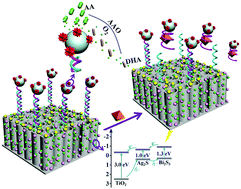当前位置:
X-MOL 学术
›
Chem. Commun.
›
论文详情
Our official English website, www.x-mol.net, welcomes your feedback! (Note: you will need to create a separate account there.)
An in situ electron donor consumption strategy for photoelectrochemical biosensing of proteins based on ternary Bi2S3/Ag2S/TiO2 NT arrays
Chemical Communications ( IF 4.9 ) Pub Date : 2017-12-22 00:00:00 , DOI: 10.1039/c7cc08132d Bing Wang 1, 2, 3, 4, 5 , Jun-Tao Cao 1, 2, 3, 4, 5 , Yu-Xiang Dong 1, 2, 3, 4, 5 , Fu-Rao Liu 1, 2, 3, 4, 5 , Xiao-Long Fu 1, 2, 3, 4, 5 , Shu-Wei Ren 3, 4, 6 , Shu-Hui Ma 3, 4, 6 , Yan-Ming Liu 1, 2, 3, 4, 5
Chemical Communications ( IF 4.9 ) Pub Date : 2017-12-22 00:00:00 , DOI: 10.1039/c7cc08132d Bing Wang 1, 2, 3, 4, 5 , Jun-Tao Cao 1, 2, 3, 4, 5 , Yu-Xiang Dong 1, 2, 3, 4, 5 , Fu-Rao Liu 1, 2, 3, 4, 5 , Xiao-Long Fu 1, 2, 3, 4, 5 , Shu-Wei Ren 3, 4, 6 , Shu-Hui Ma 3, 4, 6 , Yan-Ming Liu 1, 2, 3, 4, 5
Affiliation

|
An ascorbic acid oxidase (AAO)–ascorbic acid bioevent-based electron donor consumption mode was introduced into the PEC bioassay for the first time. Ternary hybrid bismuth sulfide/silver sulfide/TiO2 nanotube arrays as the photoelectrode coupled with AAO attached to SiO2 as a dual signal quenching strategy were employed for sensitivity enhancement.
中文翻译:

一个原位用于蛋白质的光电化学生物传感基于三元铋的电子供体的消耗策略2小号3 /银2 S /的TiO 2 NT阵列
首次将抗坏血酸氧化酶(AAO)-基于抗坏血酸生物事件的电子供体消耗模式引入了PEC生物测定中。采用三元杂化硫化铋/硫化银/ TiO 2纳米管阵列作为光电极,并结合AAO附着在SiO 2上作为双信号猝灭策略,以提高灵敏度。
更新日期:2018-01-18
中文翻译:

一个原位用于蛋白质的光电化学生物传感基于三元铋的电子供体的消耗策略2小号3 /银2 S /的TiO 2 NT阵列
首次将抗坏血酸氧化酶(AAO)-基于抗坏血酸生物事件的电子供体消耗模式引入了PEC生物测定中。采用三元杂化硫化铋/硫化银/ TiO 2纳米管阵列作为光电极,并结合AAO附着在SiO 2上作为双信号猝灭策略,以提高灵敏度。


























 京公网安备 11010802027423号
京公网安备 11010802027423号